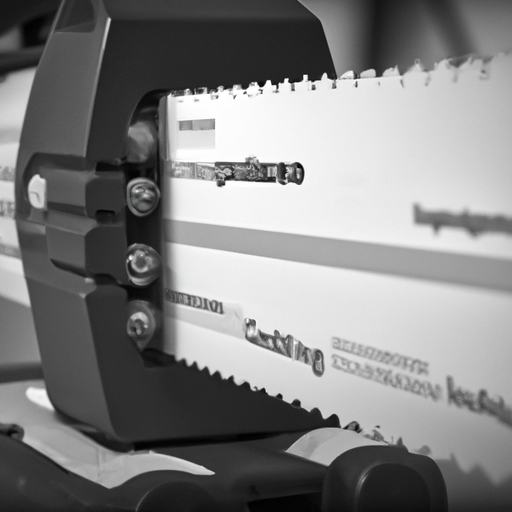Imagine you have a beautiful garden, overflowing with lush trees and unruly branches that need taming. You’ve heard about electric pole saws, these incredible tools that can effortlessly reach those far-off branches. But before you grab one, you might wonder, are electric pole saws safe? In this article, we will explore the safety features of electric pole saws and unveil some tips to ensure a secure and enjoyable gardening experience. Electric pole saws are a convenient and efficient tool for trimming tree branches and performing other outdoor tasks. However, like any power tool, they can pose certain safety risks if not used properly. To ensure your safety while using an electric pole saw, it is important to understand the different types of pole saws available, the safety features they possess, the precautions to take, and the common hazards associated with their use. Additionally, proper maintenance, storage, training, and certification should be considered to enhance your safety. In this article, we will explore all of these aspects in detail so that you can make an informed decision and use your electric pole saw safely and effectively.
Types of Electric Pole Saws
Corded Electric Pole Saws
Corded electric pole saws are powered by electricity and require a constant connection to an electrical outlet. They are popular among homeowners with smaller yards and trees. Corded pole saws tend to be lightweight and easy to maneuver, making them ideal for beginners. However, the length of the cord can limit their range and mobility, and may require the use of extension cords.
Battery-Powered Electric Pole Saws
Battery-powered electric pole saws are also known as cordless pole saws. They are powered by rechargeable batteries, providing more flexibility and portability than their corded counterparts. This makes them a popular choice for homeowners who need to move around large yards or work in areas without easy access to outlets. However, the runtime of the battery can be limited, and it is important to ensure that the battery is fully charged before use.
Safety Features of Electric Pole Saws
Automatic Chain Brake
One of the most important safety features of an electric pole saw is the automatic chain brake. This feature stops the chain immediately when the saw encounters kickback or any other sudden movement, preventing injuries and accidents. It is essential to choose a pole saw that has a reliable automatic chain brake to ensure your safety during operation.
Safety Trigger
Another crucial safety feature found in electric pole saws is the safety trigger. The safety trigger is a secondary trigger that needs to be engaged before the main trigger can be activated. This prevents accidental starting of the pole saw, providing an extra layer of protection against injuries.
Safety Guards
Electric pole saws are often equipped with safety guards that cover the cutting area of the chain bar. These guards provide protection against accidental contact with the moving chain, reducing the risk of cuts or lacerations. It is important to ensure that the safety guards are in good condition and properly installed before using the pole saw.
Lock-off Switch
The lock-off switch is a safety feature that prevents the accidental activation of the trigger when the pole saw is not in use. It requires the release of the lock-off switch before the trigger can be engaged, adding an extra level of safety during transportation and storage.
Choosing a Safe Electric Pole Saw
Researching Brands and Models
When choosing an electric pole saw, it is crucial to research different brands and models to find one that meets your specific needs and safety requirements. Look for reputable brands that have a history of producing high-quality and reliable power tools.
Reading Product Reviews
Reading product reviews can provide valuable insights into the safety and performance of different electric pole saws. Consider both positive and negative reviews to get a balanced perspective on the product’s features, durability, and safety features.
Checking Safety Certifications
Before purchasing an electric pole saw, check if it has been certified by reputable safety organizations. Look for certifications such as UL (Underwriters Laboratories) or ETL (Electrical Testing Laboratories), as they indicate that the product has met certain safety standards.
Precautions to Take When Using an Electric Pole Saw
Wear Protective Gear
Before operating an electric pole saw, it is essential to wear appropriate protective gear. This includes safety goggles or a face shield to protect your eyes from flying debris, a helmet to protect your head, ear protection to reduce noise, gloves for a firm grip, and sturdy footwear to protect your feet from falling branches.
Inspect the Saw Before Use
Always inspect your electric pole saw before each use to ensure it is in proper working condition. Check for any loose or damaged parts, ensure the chain is properly tensioned, and inspect the safety features to ensure they are functional. Do not use the saw if you notice any defects or issues.
Follow the Manufacturer’s Instructions
Read and understand the manufacturer’s instructions and safety guidelines before using an electric pole saw. Adhere to the recommended operating procedures, including proper assembly, maintenance, and safe storage practices. Failure to follow these instructions can result in accidents or equipment damage.
Be Aware of Your Surroundings
Before starting work with an electric pole saw, carefully assess your surroundings. Look for any potential hazards such as overhead power lines, unstable branches, or obstacles on the ground. Ensure there is enough space to safely operate the saw without endangering yourself or others.
Avoid Overreaching
While operating an electric pole saw, it is important to avoid overreaching. Always maintain a stable and balanced stance, keeping both feet firmly planted on the ground. Overreaching can throw off your balance and increase the risk of accidents or falling.
Use Proper Technique
Using proper technique while operating an electric pole saw is essential for your safety. Hold the saw with both hands, maintaining a firm grip, and position yourself correctly to maintain balance and control. Use smooth, steady motions and avoid jerking or twisting the saw, as this can lead to kickback or loss of control.
Common Hazards of Electric Pole Saw Use
Accidental Starting
Accidental starting is a common hazard associated with electric pole saws. To prevent accidental starting, always ensure that the safety triggers and lock-off switches are engaged before handling or transporting the saw.
Kickback
Kickback occurs when the saw’s guide bar catches or binds in the wood, causing the bar to kick upwards towards the operator. To minimize the risk of kickback, maintain a firm grip on the saw, position yourself correctly, and avoid cutting with the upper quadrant of the guide bar.
Falling Objects
When using an electric pole saw, there is a risk of falling objects such as branches or debris. Always make sure the area below you is clear of people, animals, or valuable items that could be damaged by falling objects. Use caution when cutting branches to minimize the risk of them falling unpredictably.
Electrical Hazards
If you are using a corded electric pole saw, be aware of the potential electrical hazards. Avoid using the saw in wet conditions or near water sources to prevent electrical shock. Ensure the cord and outlet are in good condition and properly grounded.
Overhead Power Lines
When working with an electric pole saw, it is crucial to be aware of overhead power lines. Contact with power lines can cause serious injury or death. Always maintain a safe distance of at least 10 feet from power lines and call your local utility company if you need to work near them.
Falls and Ladders
Falls are a common hazard when using any type of pole saw. To minimize the risk of falls, ensure the ladder or platform you are using is stable and secure. Never overreach while on a ladder or work at heights beyond your comfort level. Consider using a safety harness or attaching the saw to a lanyard for added protection.
Maintenance and Storage Tips for Electric Pole Saws
Regular Cleaning and Lubrication
To keep your electric pole saw in optimal condition, regular cleaning and lubrication are essential. Remove any dirt, debris, or sawdust after each use, and check the chain tension and lubrication before storing the saw. Refer to the manufacturer’s instructions for specific cleaning and lubrication recommendations.
Proper Blade Maintenance
The blade of the pole saw should be kept sharp and in good condition to ensure clean and efficient cutting. Regularly inspect the blade for any signs of damage or dullness, and sharpen or replace it as needed. A sharp blade reduces the risk of kickback and promotes safer and more effective cutting.
Storing the Saw Safely
When storing an electric pole saw, ensure it is kept in a safe and secure location, away from children and unauthorized users. If the saw uses a battery, remove it and store it separately in a cool, dry place. Proper storage helps prevent accidental starting and prolongs the life of the saw.
Disposing of Batteries Properly
If your electric pole saw uses rechargeable batteries, it is important to dispose of them properly when they reach the end of their life. Contact your local waste management facility or recycling center for guidance on the safe disposal or recycling of batteries.
Training and Certification for Electric Pole Saw Use
Seeking Professional Training
If you are new to using an electric pole saw or feel unsure about your skills and knowledge, it is recommended to seek professional training. Many organizations offer training courses specifically designed for the safe and effective use of pole saws. These courses cover topics such as operation, maintenance, and safety protocols.
Obtaining Necessary Certifications
Depending on your location and occupation, specific certifications may be required to operate an electric pole saw. These certifications ensure that you have received proper training and possess the necessary knowledge and skills to operate the equipment safely. Check with local authorities or relevant organizations to determine if any certifications are necessary.
Comparing Electric Pole Saws to Other Options
Electric Pole Saws vs. Gas-Powered Pole Saws
When comparing electric pole saws to gas-powered pole saws, there are several factors to consider, including safety. Electric pole saws are generally lighter and easier to handle than gas-powered ones, making them a safer option for beginners or individuals with less physical strength. Additionally, electric pole saws produce zero emissions, reducing the environmental impact compared to gas-powered alternatives.
Electric Pole Saws vs. Manual Pole Saws
Manual pole saws, also known as pruning saws, require manual effort and are generally safer than electric pole saws due to their lack of moving parts and reliance on human power. However, electric pole saws offer greater efficiency and speed, allowing for easier and quicker tree pruning. The choice between electric pole saws and manual pole saws ultimately depends on your specific needs and comfort level with power tools.
Additional Safety Measures to Enhance Electric Pole Saw Use
Using a Safety Harness
For added safety while using an electric pole saw at heights, consider using a safety harness. A safety harness secures you to an anchor point and can prevent falls or serious injuries in case of accidental slippage.
Securing the Saw with a Lanyard
Attaching the saw to a lanyard can prevent it from accidentally falling while working at heights. A lanyard keeps the saw within easy reach and prevents it from dropping on someone below.
Installing a Ground Fault Circuit Interrupter (GFCI)
To minimize the risk of electrical shock when using a corded electric pole saw, consider installing a Ground Fault Circuit Interrupter (GFCI) on the outlet. A GFCI detects imbalances in electrical currents and automatically shuts off the power, reducing the risk of electrical accidents.
Conclusion
Electric pole saws are undoubtedly a useful tool for homeowners and professionals alike when it comes to tree trimming and outdoor tasks. However, it is crucial to prioritize safety when using these power tools. By understanding the different types of electric pole saws, their safety features, and the precautions to take, you can ensure a safe and productive experience. Remember to always wear protective gear, follow the manufacturer’s instructions, and be aware of the common hazards associated with electric pole saw use. Proper maintenance, storage, training, and certification should also be considered to enhance your safety and prolong the life of your electric pole saw. With the right knowledge, precautions, and mindset, you can confidently and safely use an electric pole saw to maintain the beauty and health of your trees.


